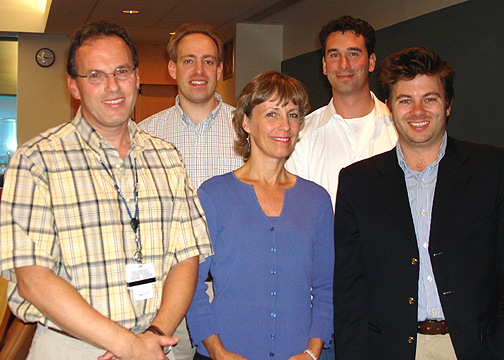
| T H E N I H C A T A L Y S T | N O V E M B E R – D E C E M B E R 2007 |
|
|
|
Research
Festival |
 |
|
Chemists:
(left to right) Nigel Greig, NIA; Daniel Appella, NIDDK; Amy Hauck Newman,
NIDA; Craig Thomas, NIH Chemical Genomics Center; and panel chair Rocky
Tuan
|
They stopped short of saying "Chemistry rocks!" but the Research Festival panelists presenting their work "From the Beaker to the Bedside" did not blunt their reverence for chemistry in the quest for diagnostic probes, therapeutic agents, and innovative paths to elucidating the nature of pathogenic processes.
Designer Drugs
Nigel Greig and Amy Hauck Newman elaborated on some of their efforts to synthesize drugs aimed at treating Alzheimer’s disease and addiction, respectively. Their ultimate objective is tech transfer.
Newman’s laboratory has synthesized dopamine D3 receptor ligands and demonstrated their selective localization and binding in the nucleus accumbens in rat brains, as well as their ability to thwart the compulsion to cocaine relapse in squirrel monkeys.
The D3 receptor antagonists are not a "golden bullet" against all aspects of addiction, observed Newman, senior investigator and chief of the Medicinal Chemistry Section, Medications Discovery Research Branch, NIDA. "They will not block self-administration of cocaine [in squirrel monkeys], but they are very effective in the relapse model."
The team currently has a "lead candidate" among the compounds under study and is pursuing ways to optimize its bioavailability and functionality.
Greig, chief of the Drug Design and Development Section and senior investigator, Laboratory of Neurosciences, NIA, traced the development of synthetic analogues of physostigmine—from the Physostigma venenosum plant—through their testing first in animals and then in clinical trials in patients with Alzheimer’s disease.
The novel agents—phenserine, a selective acetylcholinesterase inhibitor, and its enantiomer, posiphen—were designed to inhibit the synthesis of the amyloid-b precursor protein (APP).
Both have been found to lower APP and amyloid-b in mouse brains, and both have moved into clinical trials. Results thus far with phenserine are promising, Greig said, showing a dose-related lowering of amyloid-b plaques compared with placebo.
Posiphen, now in phase 1 clinical trial, may prove more beneficial than phenserine, he added. Cholinergically inert and therefore not associated with the nausea and vomiting that may accompany phenserine, the drug is better tolerated in humans and can be administered in higher doses (120 mg compared with 15 mg), he said. He speculated on the possible value of combining the two.
Molecules and Probes
Providing the molecular tools to identify, interrupt, or otherwise manipulate pathogenic and genetic mishaps is the daily work of Craig Thomas and Daniel Appella, whose efforts serve the needs of investigators across the NIH institutes.
One such need was reflected in the question, "Could a misfolded protein refold with the aid of a chemical chaperone?" Thomas recalled.
The answer was critical to devising a new approach to Gaucher disease, a lysosomal storage disorder characterized by 200 point mutations in the glucocerebrosidase (GC) gene. NHGRI’s Ellen Sidransky brought the question to the NIH Chemical Genomics Center (NCGC).
Quantitative high-throughput screening facilitated the identification of three novel structures with potent selective inhibition of GC, said Thomas, chemistry group leader at the NCGC.
"But optimizing was a challenge" that took four months and five rounds of synthesizing nearly 300 compounds before the team delivered four novel chemotypes across the potency range of GC inhibition with the potential of binding to the enzyme to restore shape and function, he related.
Thomas listed several other projects undertaken with both intramural and extramural labs that involved in silico docking, virtual screening, advancing cellular pathway assays, and uncovering unforeseen toxicity in a potential therapeutic agent.
A major focus of Appella’s group in the Laboratory of Bioorganic Chemistry, NIDDK, is manipulating peptide nucleic acids (PNAs) to improve their ability to bind to DNA. What’Chemically modifying these backbone units to improve their DNA binding affinity and sequence specificity in a predictable manner is aimed "not so much at making a drug but at developing a tool—for instance, to identify a pathogen" and improve diagnostic assays, Appella said.
A project to stabilize PNA-DNA duplexes—and, more recently, quadruplexes—by incorporating cyclopentane into different PNA sequences "has been a synthetic challenge—now in its third iteration," Appella recounted, "but we have demonstrated, after a lot of work, that binding is improved."
The group
has synthesized PNA capture and detection probes and is working on sidechain
incorporation to develop improved light-up probes. The team developed a "PNA
sandwich-hybridization" assay that can be used to distinguish protective
antigen from anthrax. The lab’s latest project involves tethering three
PNA sequences together that simultaneously clamp onto DNA to form a highly stable
complex. ![]()